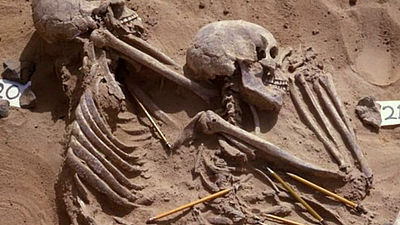Stone tool cuts on 1.45 million-year-old fossil bones reveal earliest evidence of ancient human relatives killing and eating each other

Researchers at the Smithsonian's National Museum of Natural History say they have found the earliest conclusive evidence that our relatives likely killed and ate our relatives as well. Did. This research was reported in a paper published in the journal Scientific Reports on June 26, 2023.
Early Pleistocene cut marked hominin fossil from Koobi Fora, Kenya | Scientific Reports
Humans' Evolutionary Relatives Butchered One Another 1.45 Million Years Ago | Smithsonian Institution
https://www.si.edu/newsdesk/releases/humans-evolutionary-relatives-butchered-one-another-145-million-years-ago
Brianna Poviner, a paleoanthropologist at the Smithsonian's National Museum of Natural History and the lead author of the paper, initially explored the possibility that ancient carnivores were eating prehistoric human relatives.
However, when I observed the collection of the Nairobi National Museum in Kenya with a magnifying lens on hand, there were marks that looked like cuts made by a tool rather than the tooth marks of a carnivore.
Below is the tibia.

To find out what the marks were, Poviner took impressions of the cuts using the same material that dentists use to make impressions of his teeth, and sent them to co-author Michael Pante of Colorado State University. Mr. Poviner said that he requested an inspection without revealing what type it was so as not to give Mr. Panthe a preconceived notion.
Mr. Panthe 3D scanned the mold and compared it with 898 databases such as tooth molds and traces of dismantling that have been found so far, two of the 11 traces are large cats like lions. It turns out that there is a high possibility that it is a bite mark. Poviner speculates that the skeleton's owner lived to be one of the three species of

Instead, 9 out of 11 matches exactly with stone tools. The presence of stone tool marks on the bones doesn't necessarily mean that the meat was eaten, but Poviner thinks it's likely. Because the cut marks were where the calf muscles connect to the bone, and it was the perfect place to scrape the chunks of meat off the bone. Almost all of the cut marks were in the same direction, so it is thought that the stone tool user dismantled it at once without adjusting the grip or angle.
Of the following, 5 and 6 are from carnivorous teeth, the rest from stone tools.

'These mutilation marks are very similar to what I have seen in fossilized animals that have been processed for food,' Poviner said. This suggests that hominids may have been eating other hominids at least 1.45 million years ago. We've found other traces of this, but this fossil shows that they were eating each other long before we knew it.'
When I hear stories like this,

The bone in question was originally identified in 1970 as belonging to the species 'Australopithecus boisei', but in 1990 it was changed to ' Homo erectus '. However, subsequent research has settled on the conclusion that we do not know what kind of bone it is. Also, the user of the stone tool that cut this bone is unknown. So, the fossil could be evidence of prehistoric cannibalism, but it could also be evidence that a close relative of our ancestors ate another close relative.
Regarding the new findings brought about by the fossils discovered half a century ago, Mr. Poviner said, ``If you look closely at the museum's collections again, you may find surprising discoveries. We can't see through everything, so scientists need to bring together various technologies and questions to expand the knowledge of the world, ”he emphasized the importance of a community of scientists.
Related Posts:
in Science, Posted by log1l_ks







